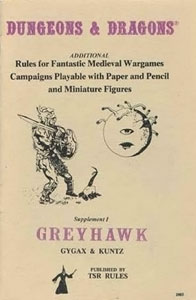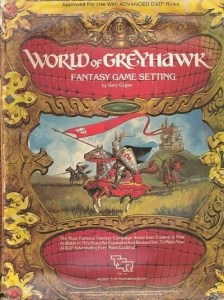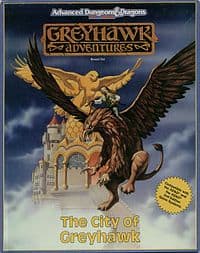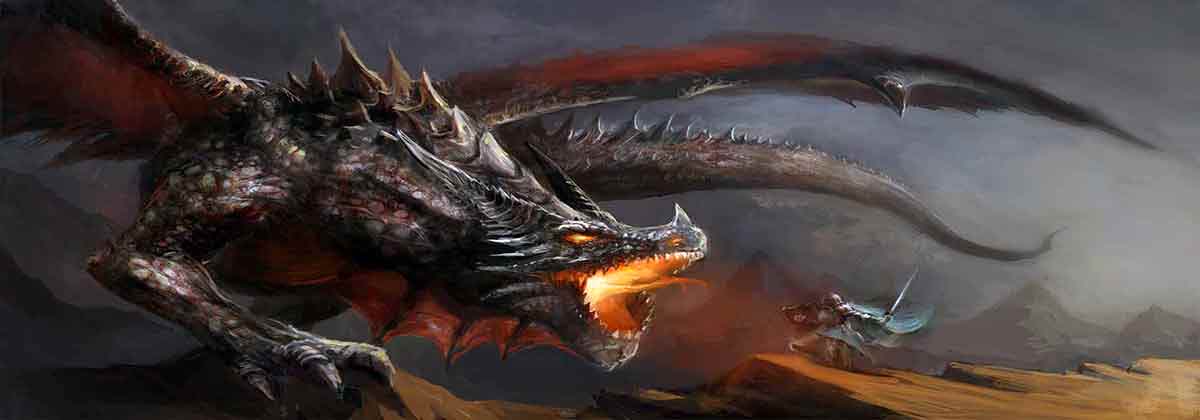One cannot have Dungeons and Dragons without Greyhawk. Sure, there have been other settings in the history of the game. There have even been settings that have arguably been more successful. At the heart of the game, though, is Greyhawk – still sitting around, still waiting for adventurers to come through and add to the legacy of the setting. Greyhawk has, in many ways, become more than a setting – it’s a core part of the D&D identity, influencing game design even when the setting isn’t active. If you love Dungeons and Dragons, you have to give at least a nodding bit of respect to one of its earliest worlds.
While Greyhawk is deeply ingrained in Dungeons and Dragons, that doesn’t mean that its legacy has been static. It has been a default setting, a popular alternative, a forgotten also-ran, and a relic over the course of its existence. The game has inspired novels and games, helped new designers to come up with role playing games of their own, and became part of the bedrock foundation of the role playing world. Greyhawk is without any exaggeration one of the most important things to happen to the world of role playing games. Whether it can compete today, though, is up to the individual player.
Early development
While Greyhawk is usually thought of as the key D&D setting during its early days, it wasn’t actually the first D&D setting. Instead, it spun out of the earliest conversations that concerned the development of the game itself. Greyhawk is a setting that owes quite a bit to the genesis of early Dungeons and Dragons.
As most role playing game history buffs know, Dungeons and Dragons is a game that really had two fathers early on. Gary Gygax created a set of rules for one on one combat, magic, and monsters to supplement the game chainmail. At roughly the same time, Dave Arneson started adapting the role playing elements of Braunstein to the fictional Barony of Blackmoor.
When Gygax and Arneson came together, one of the first things that Gygax created was a fifty page rule book that was meant to supplement a campaign in Castle Greyhawk. Gygax’s children would be the first play testers of the setting, with a group of adults following them shortly thereafter.
About a month after the initial play test, Gygax created the city of Greyhawk. By that point, the basics that would become Dungeons and Dragons were starting to settle and the setting itself would lend itself to most of the tropes that players have come to know and love.
Try my AI Tabletop RPG generators...and an extensive library of content!
Homebrew campaign (1972–1979)
Like almost every other setting in Dungeons and Dragons history, Greyhawk began its life as a homebrew campaign. This was Gary Gygax’s personal world, and it would exist as both a fertile ground for creating new role playing concepts and a testbed for the rules that would come to define Dungeons and Dragons.
Greyhawk was a setting that grew more by necessity than by a dedicated plan. Gygax continued to develop the world around Castle Greyhawk almost only because the players were beginning to venture outside the environs of the castle. He had no intention of creating a real world map, instead simply drawing over a blank map of North America to give players some idea of the scale of the world.
Gygax was also very dedicated to creating more levels for the dungeon of Castle Greyhawk itself. Only three players ever made it to the bottom of Castle Greyhawk’s dungeon, and their reward for doing so was being transported to the far side of the world.
As a campaign, Greyhawk was incredibly popular. Players crowded Gygax’s basement to play, eventually leading to the promotion of player Rob Kuntz to co-DM of Greyhawk. Gygax himself would continue to develop new concepts and characters for the setting for the next several years.
⚔️ Fantasy RPG Random Tables Books
Make life as a Gamemaster easier…
If you play Dungeons & Dragons, Pathfinder, or other fantasy RPGs, this
RPG random tables series
is packed with encounters, NPCs, treasure, and more. Available in eBook or print—either way, you’ll have a wealth of adventure ideas at your fingertips.
The World of Greyhawk folio edition (1980)

Greyhawk moved from a simple homebrew game to a legitimate campaign setting during the lead up to the Folio Edition. 1975 saw the publication of Supplement I: Greyhawk, which expanded on the rules of Dungeons and Dragons. Curiously, it also failed to detail anything about the Greyhawk world. There were a few references to the setting, but it was otherwise ignored in favor of the rules.
When AD&D was released in 1978, there were a number of references to Greyhawk and Gygax’s campaign. This, combined with Gygax’s descriptions of the setting, piqued the interest of many players. While Gygax had assumed that players would all want to build their own worlds, it soon became apparent that many players wanted to play in the world of Greyhawk.
In August of 1980, a 32-page folio was published that gave some details of the world of Greyhawk. While successful, it left out a great deal of information – including any mention of Castle Greyhawk. It was a short book, but one that helped to build up the fame of the Greyhawk setting at the same time. At this point, Greyhawk was more than just Gygax’s campaign – it was an integral part of the world of D&D.
Between editions (1980–1983)
A great deal of the work of building up Greyhawk was done between the published editions. Gygax had planned on releasing information about the world in his Dragon Magazine column, but a number of other projects intervened. Instead, it would be around a year after the publishing of the Folio that new information would start to drip out.
A great deal of the information about Greyhawk would be published in Dragon. Gygax detailed the political regions of the world, as well as the deities and NPCs that were important on Oerth. Racial characteristics, mode of dress, and even descriptions of the main Greyhawk characters would also be included in the magazine.
All the while, more supplements in the Greyhawk world would be continued to be published for the game. There were seventeen supplementary adventures that took place in Greyhawk, as well as two larger super modules. This was only a fraction of what was planned to be published, but it was still a clue that the Greyhawk setting was gaining popularity among the players.
It’s surprising that so much about Greyhawk was published between major editions. Indeed, it could be said that the world of Greyhawk didn’t really start to come together until after the first Folio had been published.
World of Greyhawk boxed set (1983)

The boxed set radically changed the view that players would have of Greyhawk. Four times longer than the folio, this helped Greyhawk to become a fully-fledged setting in which players could run adventures. It still stuck to the original concepts, but included much of the information that Gygax had fleshed out in Dragon Magazine.
The biggest change was the addition of deities – fifty Greyhawk deities would now be outlined in the boxed set, though most of them wouldn’t have full write-ups.
It’s important to note that this edition was the most comprehensive collection of Greyhawk material up to that time, but it wasn’t necessarily all of the material. Dragon Magazine had been, and continued to be, an important supplement for people who wanted to know everything about the setting. Even with that said, the release of the boxed set did help to fill in the blanks for those who didn’t have access to the magazine.
The boxed set was wildly successful, and helped to push Greyhawk forward as a primary D&D setting. While more information would be published in years to come, it was this boxed set that continued to be the primary source for all things Greyhawk.
⚔️ Fantasy RPG Random Tables Books
Make life as a Gamemaster easier…
If you play Dungeons & Dragons, Pathfinder, or other fantasy RPGs, this
RPG random tables series
is packed with encounters, NPCs, treasure, and more. Available in eBook or print—either way, you’ll have a wealth of adventure ideas at your fingertips.
Post boxed set (1984–1985)
The years after the release of the boxed set were among the busiest for Greyhawk. The boxed set had been the first step towards really fleshing out the world of Oerth, and the rest of the world would soon get the same treatment that the Flanaess had gotten in the Folio and Boxed set. Greyhawk was poised to grow.
it was during this time, though, that others began to play in the Greyhawk sandbox. As Gygax’s output slowed, writers like Len Lakofka, Frank Mentzer, and Francois Froideval began to create material in the world. Greyhawk was slowly becoming more of a group effort as Gygax began to spend more time in Hollywood.
During this time, Greyhawk did begin to fade. Dragonlance was becoming increasingly popular, and TSR began to throw a considerable amount of resources behind that setting. Gygax considered the novels to be one of the major reasons why Dragonlance was so successful, so he began to write novels in the world he had created.
It was at this point that Greyhawk began to get most of its support through Dragon Magazine. It was the clear the heyday of Greyhawk was over, even if Gary Gygax himself was continuing to push for the relevance of the setting.
Greyhawk without Gygax (1986–1987)
TSR ran into significant financial difficulties without Gygax around, and his return to the company was met with a number of major struggles. By the end of 1985, Gygax was forced out of TSR and he took a number of his characters with him.
The plans for Greyhawk changed drastically without Gygax around. There would be no more expanding of the planet’s geography, but instead the focus would stay on the single continent and the Flanaess would be the only region of note. The ambitious plans for detailing an entire world would come to a halt.
Indeed, by this point a new setting was taking over for Greyhawk – Forgotten Realms. The bulks of TSR’s efforts went into promoting this new setting. leaving the venerable Greyhawk behind. Only three Greyhawk modules would be published between 1986 and 1987, all of which were collections of old material. New work on Greyhawk had been almost completely stopped.
A module titled Castle Greyhawk was released in 1988, but it had almost nothing to do with the original setting. It was, however, the only bit of new material released under the Greyhawk banner in three years. Full of inside jokes and pop culture references, it was a far cry from the original works that inspired it.
Greyhawk revived (1988–1990)

By 1988, TSR had become much more successful at keeping multiple settings running. The first cycle of Dragonlance was complete and Forgotten Realms was up and running. When Jim Ward, one of the original Greyhawk players, came aboard, ideas were solicited for a hardcover sourcebook for the Greyhawk campaign setting.
Try my AI Tabletop RPG generators...and an extensive library of content!
A new boxed set, The City of Greyhawk Boxed Set, was released in 1989 alongside the second edition of Advanced Dungeons and Dragons. This was not the same city that Gygax had created, but rather an entirely new work using the same name. The boxed set expanded the setting and reworked some of Gygax’s original ideas to create a more cohesive world.
Several modules were released under the Greyhawk Adventures banner, including Greyhawk Ruins. Greyhawk Ruins was notable for being a different castle than that created by Gygax, but it was still one of the first attempts to publish any real information about the titular castle. The modules were all successful, albeit not quite as successful as those published early on. Still, they were able to hold their own against the other settings that were published by TSR.
Greyhawk was back, now as one of many potential settings. Things were still changing, though, and Greyhawk’s future would be in flux.
A new vision of the Flanaess (1991–1997)
By 1990, Greyhawk’s world was a bit worn out. TSR decided that it was time to give things a makeover, and that meant finding a way to refresh the world that Gygax had created. Instead of moving outside the initial region, TSR decided to move the time frame forward so they could radically reorder the world. The Flanaess would see a major war, and afterwards a huge shake-up in the alliances and kingdoms that made up the region.
Greyhawk’s changes would occur through a series of modules that detailed the war in Greyhawk, followed by a new supplementary source book. The main source for information was the City of Greyhawk boxed set, but the new book would update the city and setting to be more in line with the new plans for the Flanaess. The update was meant to breathe new life into the setting.
Dragon Magazine still played a huge role in fleshing out Greyhawk. A great deal of new information was still published in Dragon, pending the release of a new source book. All the changes in Greyhawk were meant to help breathe new life not just into the setting, but to help a financially struggling TSR.
Wizards of the Coast (1998–2008)
In 1994, TSR stopped publishing Greyhawk. The decision, it seems, was more due to the company’s poor finances than anything else. By 1996, the company was unable to pay its printers. Just before declaring bankruptcy, the company would be bought by Wizards of the Coast.
Peter Adkinson, the CEO of Wizards of the Coast, was a major fan of Greyhawk. Along with creating a new Third Edition rule set, he made reviving Greyhawk a priority for the company. All of the previous information about Greyhawk was pulled together, and a decision was made to move forward with the storyline.
Greyhawk returned with the adventure Return of the Eight, followed by the Greyhawk Player’s Guide. The book moved the story forward and gave a condensed version of all the information presented in both previous versions of Greyhawk. A great deal of new material was published, and the story line moved back to the world of adventure that was originally created by Gygax.
The 25th Anniversary saw many calls back to the original Greyhawk. A number of nostalgic modules were produced, and third edition would see Greyhawk become the default setting of the game for the first time. RPGA would also begin Living Greyhawk, one of the largest and best organized large campaigns ever devised.
Death of Greyhawk? (2008 to present)
It’s hard to kill off a fictional setting, but even its most strident adherents must admit that Greyhawk has at least been on life support since 2008. It was at this time that the Fourth Edition of Dungeons and Dragons was released and that Greyhawk officially lost its status as a default setting. With that torch now taken up by the Forgotten Realms, it very much looked like Greyhawk would be fading into the background.
Things were worse when players realized that Greyhawk was really going to be removed from the game. There was no Fourth Edition material created for the world of Greyhawk, with the lone exception being a supplement made specifically for RPGA members. Greyhawk wasn’t just being removed from its status as a primary setting, it was being totally phased out.
The final blow came with the death of Living Greyhawk. The long running world was shuttered in favor of a living version of Forgotten Realms. When even the most hardcore fans of the world walked away, it was clear that things were over.
Fifth Edition has paid at least a little attention to Greyhawk. While Forgotten Realms is still the primary setting, there are mentions of things relating to Greyhawk and its deities in the various sourcebooks. For now, though, it looks like Greyhawk is at least being relegated to the role of a fond memory.
Unofficial Greyhawk
While TSR and WotC may have owned the official rights to Greyhawk, that didn’t mean that the series would only continue there. Gygax still owned the rights to several characters, and he continued the adventures of Gord the Rogue on his own. By 2003, Gygax and Kuntz began work on Castle Zagyg, an adventure that would finally put the details of Castle Greyhawk on paper.
⚔️ Fantasy RPG Random Tables Books
Make life as a Gamemaster easier…
If you play Dungeons & Dragons, Pathfinder, or other fantasy RPGs, this
RPG random tables series
is packed with encounters, NPCs, treasure, and more. Available in eBook or print—either way, you’ll have a wealth of adventure ideas at your fingertips.
The project came to a halt when Gygax suffered a stroke in 2004, though bits and pieces of the project have been completed since. Several of Kuntz’s original levels would also be published over the course of the next few years, but Greyhawk’s unofficial second life really came to an end at the same time as that of its primary creator.
Greyhawk Novels
Like Dragonlance and the Forgotten Realms, Greyhawk was the home to several D&D books as well as the game modules. A number of the books were initially written by Gary Gygax himself, largely to help promote the setting in the same way that Dragonlance had been promoted with its novels. The tales of Gord the Rogue were well-received, though their connection to Greyhawk came to an end when Gygax left TSR.
A number of other Greyhawk novels would be published over the years, with their heyday in the late 80s and early 90s. The books served as a great way to flesh out the setting, giving life to a series that usually only had cryptic information available in the source books. While note necessarily as successful as the Forgotten Realms or Dragonlance books, they did help to round out the overall library of Dungeons and Dragons novels.
Greyhawk Legacy
The legacy of Greyhawk is easy to see when you look at the world of role playing games. Even as it was surpassed as a setting, bits and pieces of the world continued to sneak into other settings. Some of the most popular role playing spells and characters are modeled on those found in the game, and it’s rare that any game will be able to avoid the tropes represented there.
If nothing else, Greyhawk helped to soldify the dungeon crawl as a huge part of the role playing game world. Not only would it become the default type of game for the table top, but it would also inspire many early video games. From the basic party to the search for treasure, Greyhawk set the tone for many different types of games.
Greyhawk remains one of the most important settings to ever grace Dungeons and Dragons. It was there since before the beginning, grew with the game as it became a hit, and is slowly starting to creep back into the minds of modern gamers. Whether it’s the original setting, the flavor it brought to millions of campaigns, or just the books it inspired, Greyhawk has played an important role in helping to grow the imaginations of generations of role playing game fans. For some, Greyhawk is more than words on a page – it’s a world that has grown with the players who loved it.
What does the future hold for this venerable setting? It’s hard to say. There are signs that it might come back in some form during Fifth Edition. There’s always the possibility that it could spin off into its own game, like so many other settings have done in the past. One thing that’s sure, though, is that it will continue to exist in some way, shape or form. You can’t make an idea like Greyhawk go away – you can just keep it out of the spotlight. Greyhawk will continue to matter as long as there are people around to remember its glory days.










